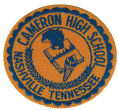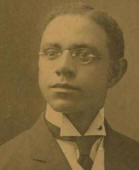| CAMERON HIGH SCHOOL |  "The Mighty Panthers" |
|
|
Professor
Henry graduated in 1892 from Meigs High School in East Nashville - the first black public high school in the city of Nashville. In 1896, he was awarded a B.A. degree from Fisk From many newspaper accounts of Professor Cameron during his time, he was often described as a person of unusual mental ability and extraordinary physical fitness. He was a sports enthusiast who became the first basketball and baseball coach at Pearl High. He possessed a deep love for his students and they in turn adored him immensely. He had a multitude of dear friends, cherished his wife Louise and involved himself in an array of successful business ventures. Professor Cameron was actively engaged in the social, political and civic life of his community and was often found in the company of the prominent Nashville luminaries of his day such as J. C. Napier, R. H. Boyd, Preston Taylor, John Wesley Work Jr. and others. A November 13th, 1915 article in the Nashville Globe describes a music recital in which Mr. Napier, Mr. Taylor and Professor Cameron were in attendance. One of his closet friends was George E. Washington (on 2nd row in picture above) - mentor, teaching colleague at Pearl, business partner and namesake of Washington Jr. High School in Nashville which is now extant. By 1915, the Professor was a member of the Republican party (as most African-Americans were during that time), Head Science Teacher at Pearl High; President of the Middle Tennessee Teacher Association; Secretary of the Tennessee Aid Assn.; Member of the Nashville Teacher’s Literary and Benefit Assn; a 32nd degree Mason; Fraternal Member of the Knights of Pythias and the Grand Lodge of Tennessee and President of the Capital City Baseball League which consisted of 8 teams based in the Nashville area. He was also a beloved Elder of his church in Nashville - St. Andrews Presbyterian Church located on Capitol Hill at the time. In April 1917, with a terrible war going on in Europe, the United States decided to enter this conflict against the Germans. Professor Cameron, at the age of 45, took a leave of absence from teaching at Pearl in June of that year to volunteer for the war effort. On October 15, 1917, he was commissioned as a 1st Lieutenant in the US Army at Fort Des Moines, Iowa (see graduating picture below), a facility established especially for training black officers in WWI.
After attending other training facilities at Camp Grant in Illinois and Camp Upton in New York, Professor Cameron, now Lieutenant Cameron, sailed for France on June 10, 1918. Two days before leaving, he wrote his Last Will and Testament, a document now housed at the Eva B. Dorsey Library at Cameron School. He was assigned to Company M, 365th Infantry, 92nd Division – one of three black Infantry Divisions in combat during World War I. For some unknown reason, the US Army reversed Lt. Cameron’s first and middle names and he was listed in his service records as Alvin H. Cameron instead of Henry A. Cameron. As an officer, he was a fastidious and capable leader who always cared about the safety and well-being of the men under his command. They succeeded in winning many battles against a fierce and determined German army in the face of insurmountable odds. On October 30th 1918, during the Battle of Argonne Forest, France - one of the bloodiest battles of the war - Lt. Cameron was killed in action while on a scout patrol with his unit. The city of Nashville went into a state of panic upon hearing the news of his death. He was the first of only three black men appointed officers in WWI from Tennessee and the first black officer to die from Tennessee. Lt. Cameron's body was not brought back to Nashville. His remains are in France at the St. Mihiel American Cemetery in Thiacourt, France. His name can be found on the American Battle Commission Honor Roll site for soldiers who fought in WWI at http://www.abmc.gov/search/wwi.php. (Once you get the page enter “Cameron Alvin”). Posthumous medals conferred upon 1st Lieutenant Henry Cameron for bravery in action during World War I include: (1) the Croix de Guerre (awarded by the French); (2) the Meusse-Argonne with St. Die defensive clasps; (3) the World War I Victory Medal with battle clasps and (4) the Purple Heart. Due to overt discrimination shown against black soldiers who fought in this war, Lt. Cameron and others did not receive the Congressional Medal of Honor (Only one black soldier who served in WWI, Corporal Freddie Stowers, has received this medal. It was awarded posthumously to his family by President George Bush in April 1991. Also, only one woman to date has been given this medal).
--compiled and researched by Donald L. Johnson '71 |
| CAMERON HIGH SCHOOL ALUMNI ASSOCIATION, INC. (CHAA) P. O. BOX 681 ANTIOCH, TENNESSEE 37011-0681 panthers@cameronalumni.net © 2006 Cameron High Alumni Association, Inc |


 Additionally, on November 26, 1928, in a show of honor and respect for Professor Lt. Cameron, the Nashville City School Board named Cameron School in tribute to this man who stood for the highest example of civic duty by giving his life unselfishly for his country. His distinguished career as an educator, businessman, community leader, coach and soldier leaves an indelible testimonial of scholarship, commitment and public service for all of us to
Additionally, on November 26, 1928, in a show of honor and respect for Professor Lt. Cameron, the Nashville City School Board named Cameron School in tribute to this man who stood for the highest example of civic duty by giving his life unselfishly for his country. His distinguished career as an educator, businessman, community leader, coach and soldier leaves an indelible testimonial of scholarship, commitment and public service for all of us to